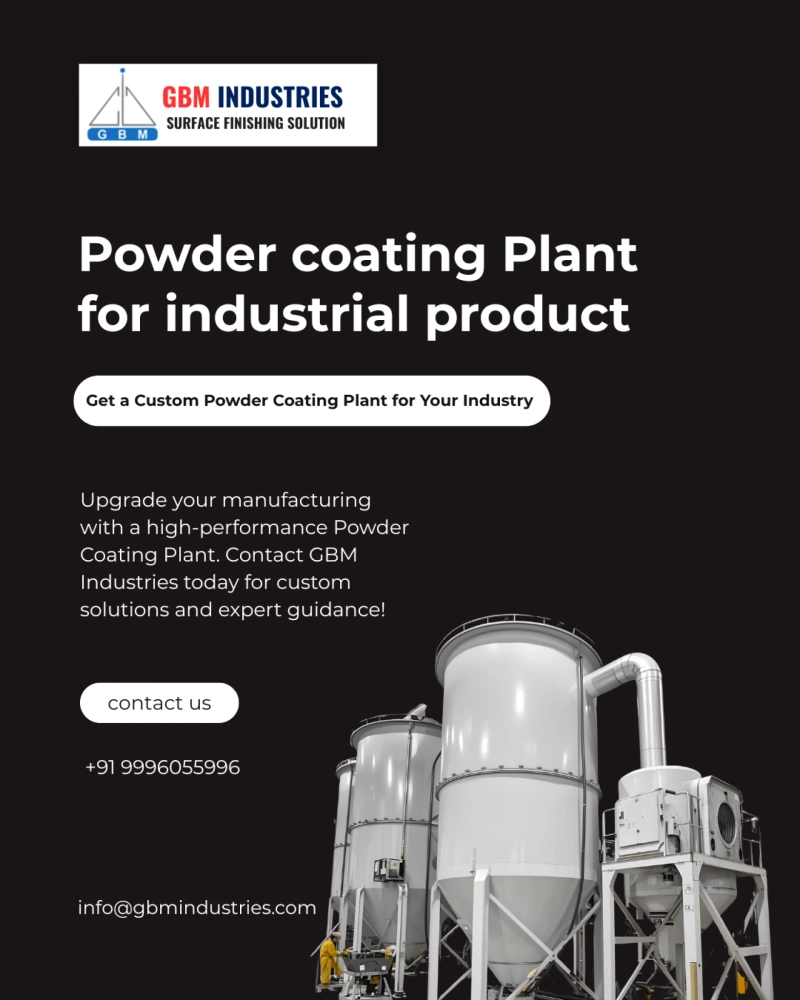Powder coating Plant
Powder coating has become one of the most reliable and efficient finishing methods for industrial products. It delivers a premium look, superior durability, and highly economical performance. With the rising demand for long-lasting coatings, powder coating plants are now widely used across industries such as automotive, electrical, furniture, architectural metalwork, and heavy machinery.
GBM Industries offers a high-performance powder coating plant, designed for precision, efficiency, and sustainable production. From manual powder coating setups to fully automated conveyor-based plants, GBM provides customized solutions to meet the specific requirements of modern manufacturing.
Process in industrial powder coating
Industrial powder coating involves three key stages: pre-treatment, powder application, and curing. For large-scale operations, automated powder coating lines ensure consistent output and improved process efficiency. For small batches or custom parts, manual powder coating guns and booths are ideal.
At GBM, each powder coating plant is engineered to provide uniform coating thickness, fast color change, efficient powder recovery, and reduced operational costs.
1. Pre-Treatment
Pre-treatment is the first and most important step in powder coating. The surface must be clean, grease-free, and properly prepared for strong adhesion. Depending on the workpiece, sandblasting or chemical cleaning is used to remove rust, oil, and impurities. For parts requiring high corrosion resistance, an additional wet chemical protective layer is applied before coating.
2. Application
Powder coating requires an electrically conductive surface, which makes metals ideal. Wood like MDF can also be coated due to its natural moisture, while plastics need a conductive primer. During application, the workpiece is grounded and the powder is electrostatically charged. This charge is created either through Corona charging, which offers flexibility for various finishes, or Tribo charging, which is preferred for extremely smooth surfaces and tight recesses. Both methods are used in manual and automatic powder coating systems.
3. Curing
After application, the powder remains dry until it is heated in a curing oven. At temperatures between 160°C and 200°C, the powder melts and chemically cross-links to form a hard, durable coating. Low-temperature powders that cure at 130–140°C are also available, but they require careful storage and handling to prevent premature melting. Manufacturers must balance energy savings from lower curing temperatures with the added cost of maintaining a cooled supply chain.
Application areas of industrial powder coating
The GBM product range covers the entire technology bandwidth: from individual components for manual coating to highly automated complete systems. Powder coating is suitable for conductive materials due to the electrostatic process. For example, metals such as stainless steel and aluminum, pre-treated wood and MDF or heat-resistant materials such as glass and ceramics.
Advantages of industrial powder coating
- High wear resistance of the paint layer
- Wide range of color shades and surface structures
- Environmentally friendly process without solvents in production and application
- Nearly 100% use of the paint with minimal loss percentage
- Low expenditure for safety engineering
- Short training period for system operators and coaters
- Easy color change with minimal paint loss
- From manual coating up to fully automatic industrial complete systems
Save energy in your powder coating
We have developed a special energy-saving concept to keep energy consumption in the powder coating system to a minimum: The patented "Energy Efficiency Package" (EEP) is an essential component of our powder coating systems. To date, we offer the most energy-efficient powder coating systems on the market.
Canculsion
Today, powder coating plants are widely used across various industries including automotive parts, EV components, architectural aluminum profiles, electrical panels, industrial machinery, metal furniture, appliances, and heat-resistant materials like glass and ceramics. If the material conducts electricity, the powder coating process can be applied effectively.
Frequently asked questions about powder coating
1. What is powder coating?
Powder coating is a dry finishing process where electrostatic powder is applied to a surface and cured in an oven to create a strong, durable finish.
2. How does powder coating work?
The powder is sprayed with an electrostatic gun, sticks to the part, and is cured in an oven to form a smooth protective layer.
3. What can be powder coated?
Most metals like steel, aluminum, auto parts, furniture frames, and industrial components can be powder coated.
4. Which is better: powder or liquid coating?
Powder coating is more durable, eco-friendly, and long-lasting. Liquid coating is better for materials that cannot handle oven heat.


